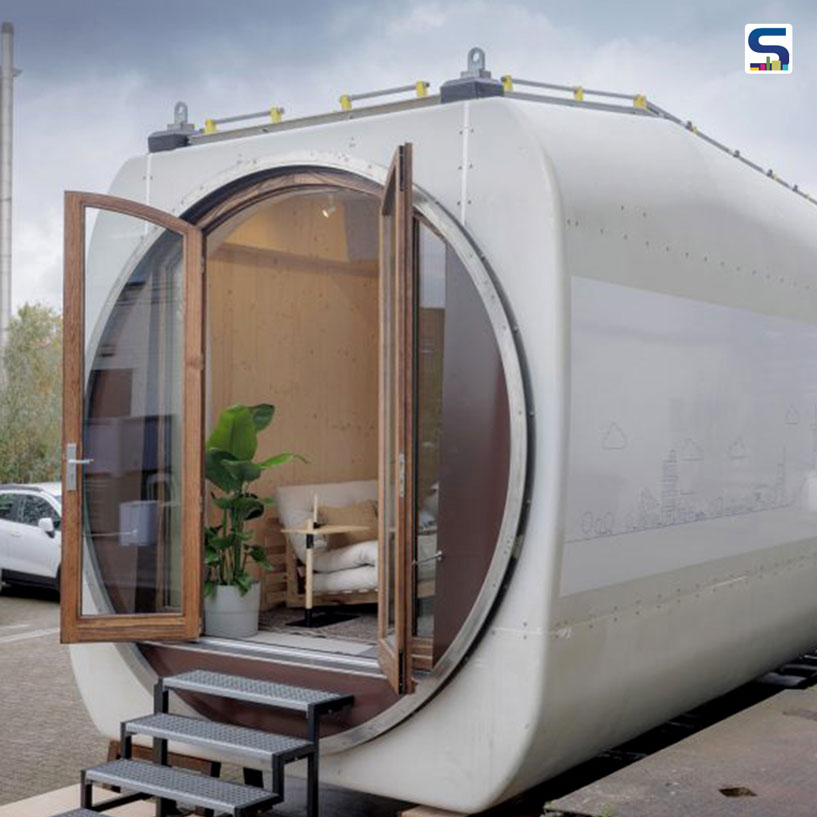
Dutch design studio Blade-Made, co-founded by architect Jos de Krieger of Rotterdam-based firm Superuse, has created a pioneering micro home from a decommissioned wind turbine nacelle, showcasing innovative reuse of renewable energy infrastructure. Named Nestle, a smart play on the term nacelle, this unique project exemplifies sustainable design, adaptive reuse, and the potential for a second life for components of wind turbines that are typically retired after 20 to 25 years of service. Know more about Nestle on SURFACES REPORTER (SR) as a striking example of how discarded energy infrastructure can be repurposed into an innovative, environmentally conscious housing.

Named Nestle, a smart play on the term nacelle, this unique project exemplifies sustainable design, adaptive reuse, and the potential for a second life for components of wind turbines that are typically retired after 20 to 25 years of service.
Upcycling Wind Turbines
Nestle emerged from a collaborative initiative led by Swedish energy company Vattenfall and the Dutch Design Foundation, which invited four design studios to conceptualize new uses for disused wind turbines. Superuse’s concept stood out for its practicality and symbolic value, converting the nacelle, the component that houses a wind turbine’s operational machinery, into a fully functional tiny house. Measuring approximately 10m in length and 4m in width, the nacelle’s size was considered just large enough to be repurposed into a compact but livable structure.

Measuring approximately 10m in length and 4m in width, the nacelle’s size was considered just large enough to be repurposed into a compact but livable structure.
De Krieger, who founded Blade-Made in 2023 to bring upcycled turbine design ideas to market, highlighted the nacelle’s similarity in material composition and engineering to the turbine blades, which have also been explored for reuse in various structures. According to De Krieger, the nacelle’s dimensions, portability, aesthetic appeal and global availability (with more than 10,000 in circulation worldwide) make it an ideal candidate for upcycling into micro dwellings or utility structures such as sheds, stables or carports.

The nacelle’s dimensions, portability, aesthetic appeal and global availability (with more than 10,000 in circulation worldwide) make it an ideal candidate for upcycling into micro dwellings or utility structures such as sheds, stables or carports.
Designing with the Wind
Externally, the structure retains its original industrial appearance, preserving the visual integrity of the turbine part. Internally, however, it has been transformed into a warm, habitable environment with thoughtful spatial planning and eco-conscious materials. The interior layout consolidates the kitchen, bathroom and technical facilities in one zone to reduce the need for extensive plumbing and wiring. This efficient arrangement frees up space for a flexible living area that can accommodate a sofa, dining area, media unit and storage. The open-plan layout also allows the space to serve multiple purposes, from a private residence to an exhibition venue or small office.
To ensure comfort and compliance with building regulations, the team faced the challenge of fitting all necessary amenities within the nacelle’s fixed dimensions. High-performance insulation was crucial, and materials were carefully selected to retain sufficient interior volume. The walls are lined with light-hued plywood to provide a cozy and neutral aesthetic, while the ceiling is finished with recycled PET felt, which enhances acoustics and continues the project’s sustainability ethos. Interior joinery was executed by local firm Woodwave.

The interior layout consolidates the kitchen, bathroom and technical facilities in one zone to reduce the need for extensive plumbing and wiring.
In line with its renewable origins, Nestle is designed to operate off-grid, drawing power from four solar panels mounted on its roof. These panels provide enough electricity to power the house and an external electric car charging station. Additional green features include a solar boiler for hot water and an air-to-air heat pump to regulate the interior climate. Triple-glazed windows, airtight seams, and robust insulation ensure minimal heat loss and optimal energy efficiency.
The nacelle used in Nestle was supplied by Business in Wind, a turbine decommissioning specialist, and originally came from a Vestas V80 turbine formerly located in Gols, Austria. Superuse and Blade-Made continue to explore similar adaptive reuse strategies, aiming to transform thousands of decommissioned turbines into sustainable, functional architecture.

Nestle is designed to operate off-grid, drawing power from four solar panels mounted on its roof.
Also in Telangana, Perala Manasa innovatively repurposed concrete sewage pipes into OPods, a 120sqft compact, mobile micro home with basic amenities that offer an innovative, low-cost solution to India’s housing crisis.
Project details
Partners: Vattenfall, Superuse, Woodwave, Business in Wind, Feenstra, Dutch Design Foundation, Reliving.nl, circuform, IMD Raadgevende Ingenieurs
Status: Realised October 2024
Location: Flexible
Image credit: Blade-Made